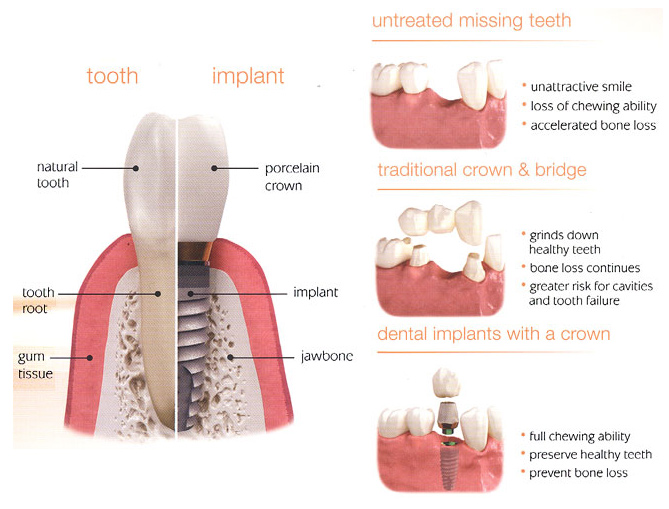Services
Bonding
 A bonding is a composite resin that is used as an alternative to amalgams and veneers. This is an excellent cosmetic option for those patients who do not want the look of silver in their mouths and do not want the expense of veneers. Bondings can be used on teeth that are decayed, cracked, or stained.
A bonding is a composite resin that is used as an alternative to amalgams and veneers. This is an excellent cosmetic option for those patients who do not want the look of silver in their mouths and do not want the expense of veneers. Bondings can be used on teeth that are decayed, cracked, or stained.
Procedure
The bonding procedure is usually completed in one visit. The first step is to remove the decayed or unsightly portion of the tooth. The tooth is then etched with a liquid or gel and a bonding agent is then applied. This will allow the composite resin to be placed in the prepared tooth. The resin is then trimmed and polished, leaving you with a beautifully sculpted, natural-looking restoration.
Bonding Durability
Although composite resins are cosmetically pleasing and easily placed, their durability is not as strong as other types of restorations. These resins typically last from 4-7 years before they begin to chip and wear away. When this happens, the restoration will need to be replaced.
Bridges
A bridge is one of the few options that you have when deciding how to deal with a missing tooth or teeth. The replacement of these missing teeth is necessary in order to maintain the proper mouth functions. Tooth loss can affect the way you eat, speak, and the alignment of other teeth in your mouth.
Types of Bridges
A bridge, by definition, is a link or connection between two permanent structures. A dental bridge is very similar in that it attaches the restorative teeth (bridge) to the natural teeth on either side of the gap. This bridge acts as your new teeth, closing the gap and restoring your smile. Bridges are often constructed of gold or metal foundations with porcelain fused to the foundation. This ensures that the bridge will support the normal functions of the mouth.
Bridges can either be fixed or removable. A fixed bridge is bonded to the natural teeth, or abutments, and can not be removed by the patient. A removable bridge is often attached by metal and can be removed for cleaning purposes. We will determine which of these options is more appropriate for your specific situation.
Procedure
The procedure begins with preparation of the natural teeth, or abutments. We will shape the abutment teeth so that the ends of the bridge will fit comfortably on each one. The next step is to take an impression of the area. This impression will be sent to our lab where your new restoration will be crafted. While this new tooth is created, we will provide you with a temporary restoration. Our temporary restorations will resemble your natural teeth so that you can continue with your daily life without worrying about a missing or unattractive tooth.
During your second visit to the office, we will proceed with the placement of your final restoration. This bridge will be fitted comfortably into the mouth. We will make every effort to ensure that the new bridge feels exactly like your natural teeth. The final step in the process is to cement the bridge into your mouth, leaving you with a beautifully restored smile.
Crowns
As we get a little older, our teeth begin to change and are prone to decay. There are many possible reasons for this change in your smile. These reasons can include bruxism(teeth grinding), general decay, cracked fillings, root canals, and many others. If your tooth is beyond repair with a filling material, we may recommend that the best viable option to save the tooth is a full crown. The reasons for this type of restoration in a badly damaged tooth are durability, cosmetic appearance, and overall support of the chewing function.
Types of Crowns
If we decide that you are in need of a full crown, there are a few different options for the repair of your tooth. These options include a full porcelain crown, a porcelain fused to metal or gold crown, or a full gold crown. We will make the determination as to which of these options is the most appropriate for your situation. You can be comfortable in knowing that your new tooth will be virtually unnoticeable and will flawlessly complement the rest of your smile.
Procedure
When we have decided to go ahead with a full crown restoration, we will set aside 2-3 appointments for the entire process. Although the majority of crowns are completed in two visits, there is sometimes a need for a third visit to ensure a proper fit.
The procedure begins with the removal of all decay in the tooth. Once we have removed the decay, we will take an impression of the tooth. This impression will be sent to our lab where your new restoration will be crafted. While this new tooth is created, we will provide you with a temporary restoration. Our temporary restorations will resemble your natural teeth so that you can continue with your daily life without worrying about a missing or incompatible tooth.
During your second visit to the office, we will proceed with the placement of your final restoration. This crown will be fitted comfortably into the mouth. We will make every effort to ensure that the new tooth feels exactly like one of your natural teeth. The final step in the process is to cement the crown into your mouth, leaving you with a beautifully restored smile.
Dental Hygiene
 In addition to the meticulous cleaning, polishing, and examination of your teeth, we also take the time to help our patients develop proper oral hygiene habits at home. We will evaluate your hygiene techniques and make adjustments to your routine where needed. Our doctors and hygienist will also make suggestions for preventative measures such as dental sealants or nightguards to protect against bruxism & TMJ.
In addition to the meticulous cleaning, polishing, and examination of your teeth, we also take the time to help our patients develop proper oral hygiene habits at home. We will evaluate your hygiene techniques and make adjustments to your routine where needed. Our doctors and hygienist will also make suggestions for preventative measures such as dental sealants or nightguards to protect against bruxism & TMJ.
If we feel that you are suffering from gingivitis or more severe gum disease, we may recommend a root scaling or planing. These measures can be instrumental in preventing bone loss and helping you to keep your natural teeth.
Dental Implants
Dental implants are becoming more popular in today's dental society for a number of reasons. Implants are utilized to offer patients a foundation for new restorative teeth where natural teeth are missing or have been extracted. The implant offers the patient the opportunity to regain normal function of the tooth without being forced to resort to a bridge or denture.
- The implant will osseointegrate (bond) with the existing bone.
- The new implant will support your teeth firmly and safely.
- You will no longer have pain during talking or eating.
- The dental implant will prevent progressive bone atrophy.
- Implants have a proven scientific basis.
Prodecure
The tooth structure has two main sections, the root and the crown. The root is the section of the tooth that is below the gumline. A dental implant acts as the restorative for this section of the tooth. The metal implant acts as an anchor in the jawbone. The first step is the surgical placement of the implant. Under regular dental anesthetic, the gum tissue is opened and the dentist places the implant into the jawbone. When this is achieved, the tissue is then sutured closed. There is not often significant discomfort with this procedure. This process can take from 1-3 hours depending on the number of implants being placed.
The implant will be left untreated for a period of 3-6 months. During this time, the bone will grow around the implant in a process called osseointergration. A removable crown may be utilized during this time period to allow for chewing and to preserve the cosmetic appearance.
The next step in the process is to attach an abutment to the tooth. This is achieved by exposing the top of the implant and placing the abutment This is the part of the implant that will support the final crown.
Finally, an impression is taken of the implant and a final restoration is crafted. This restoration will be comfortable and cosmetically pleasing. Your completed implant will be fully functional, allowing you to resume normal activities.

Root Canal
Root Canal, or endodontics, is the process of removing the nerves from the roots of a tooth. A root canal is often necessary to save an infected tooth. If an infected tooth is left alone for a long period of time, an abscess can form. An abscess will show up on an x-ray as a dark spot below the apex of the root. This is actually bone loss in the jaw. It is very important to catch this problem before it deteriorates too far.
Process
The first step of the procedure is to anesthetize the effected area. The next step is to open an access point through the top, or biting surface of the tooth. The doctor will then determine a working length of each canal. Each canal is then cleaned and shaped in preparation for the filling material. Once each canal is prepared, it is filled with an inert material called gutta percha. The canals are then sealed. The tooth is now ready for a restoration, which is usually a crown. This entire procedure is often completed in two visits.
Why do I need a root canal?
There are a number of reasons why one of your teeth may need a root canal. These include but are not limited to, a very deep cavity that extends into the nerve, a trauma to the tooth that exposes the nerve, or a crack in the tooth that extends into the nerve of the tooth.
Signs/Symptoms
- Moderate to severe lingering toothache pain when drinking hot or cold liquids or foods.
- Moderate to severe pain when biting on a tooth
- Sensitivity to tapping or pressure on the tooth
- Toothache that wakes you up in the middle of the night
- A pimple on your gum that may release pus or blood
- Radiating pain from one area of the mouth to another
Porcelains Veneers (Laminates)
Porcelain veneers are extremely thin casings of ceramic that are bonded to the front of the patients' tooth to create a new smile. Porcelain veneers are placed over the front of teeth that appear too small or large, slightly discolored, or simply are not cosmetically pleasing to the patient. For many patients, teeth may have chipped, become discolored, or are slightly crooked. For the majority of these patients, porcelain veneers can prove to be the perfect solution.
When placing porcelain veneers, we pay close attention to the patients surrounding teeth and design each veneer to complement the overall smile. The result is a beautiful, attractive new smile.
If cared for properly, your veneers will last you a long time. We ensure that your new veneers are constructed of the most durable porcelain materials available.
Procedure
The procedure begins with the preparation of the tooth. This entails removing the discolored or unsightly portion of the tooth and meticulously shaping the tooth in preparation for the new veneer. Once we have shaped the tooth, we will take an impression. This impression will be sent to our lab where your new restoration will be crafted. While the new veneers are created, we will provide you with a temporary restoration. Our temporary restorations will resemble your natural teeth so that you can continue with your daily life without worrying about a missing or incompatible tooth.
During your second visit to the office, we will proceed with the placement of your final restoration. The veneers will be fitted comfortably into the mouth. We will make every effort to ensure that the new tooth feels exactly like one of your natural teeth. The final step in the process will be to bond the new veneers into your mouth, leaving you with a beautifully restored smile.
Whitening
Over time our teeth tend to become discolored or stained. Whether this is from smoking, coffee, or any other foods, a beautiful smile could be closer than you think. We offer a safe, inexpensive solution to an unsightly smile. Whitening your teeth is a very simple procedure that can be completed in relatively short period of time.
Procedure
Our office utilizes the Zoom! chairside whitening procedure as seen on the television show Extreme Makeover. The procedure for Zoom! whitening is quick and painless. The first step is to isolate the teeth and protect the gums and lips. When this has been accomplished, the whitening gel is placed on the teeth. The gel is activated by a specially designed light that is directed at the teeth. The entire procedure takes just over an hour. The results are usually between 6 and 10 shades whiter.
Most Insurance Accepted
We participate in many insurance plans, include Cigna PPO, Delta Dental PPO, Aetna PPO, United Health Care PPO, MetLife and many more plans. Our staff is available to assist you in any insurance-related questions.
Office accepts all assignable coverage toward full or partial payment.










Complimentary Implant Consultation
Emergencies Seen Promptly




